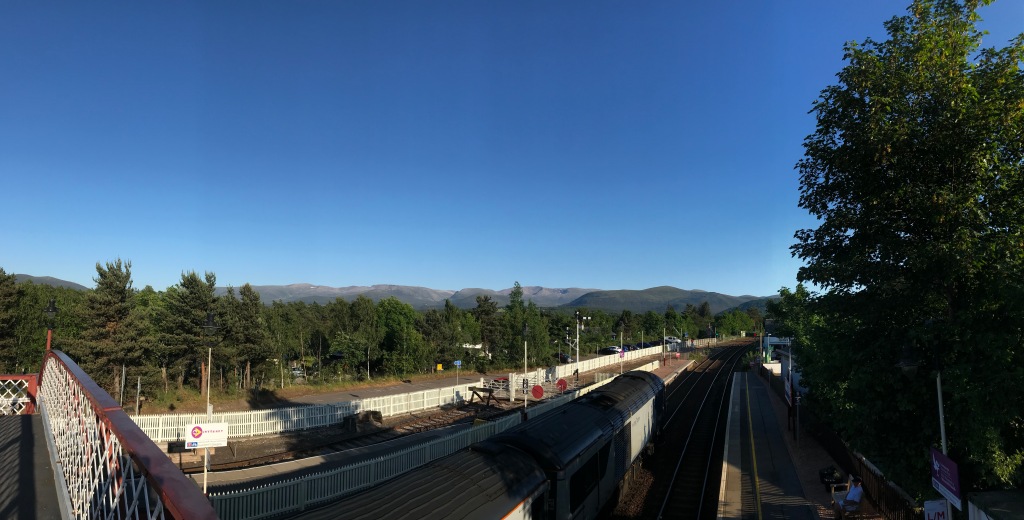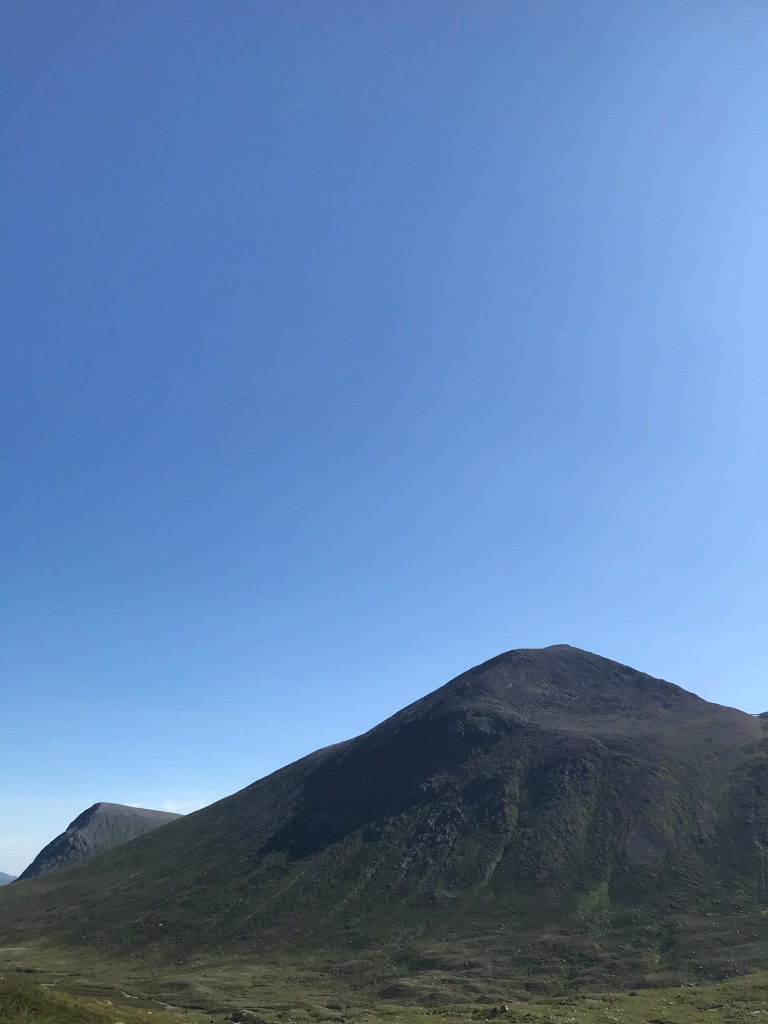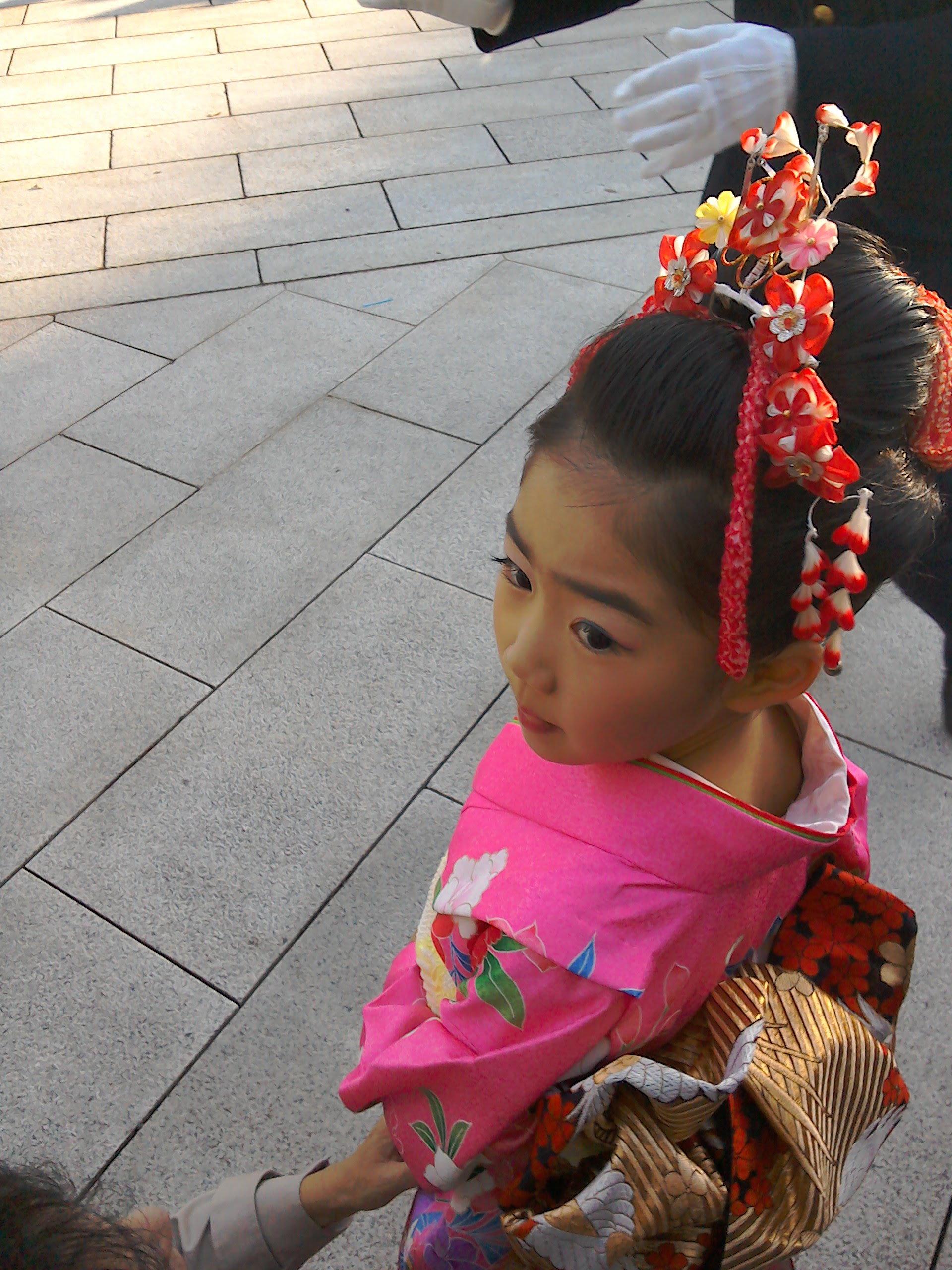I met my friend Sean on the platform at Aviemore Station in beautiful evening sunshine. He had travelled from London, I from Orkney. We climbed the steps of the Victorian railway bridge to briefly take in the vast sweep of the magnificent Cairngorms, and our objective for the following day: the greatest of Scotland’s mountain passes, the Lairig Ghru.
Next morning, we set off into Rothiemurchus Forest at nine. It was already hot, and we were glad of the shade of the pines. Dragonflies, but no midges yet, flitted round the pools at the Cairngorm Club Bridge, and Goldcrests whispered in the treetops. We began to gain height. Starting to leave the dense forest behind, we moved out onto the open heather and in the direction of the pass. We spoke briefly to an older lady walker who was already on her way downhill – she must have been out on the hills early – and Sean wondered later if she was in fact the ghost of Nan Shepherd, the Aberdeenshire author who will be forever associated with the Cairngorms, and whose book, The Living Mountain, was part of the reason we were making our trip. This walk had been a long time in the planning, and it was thrilling to finally be making our way into the pass in the hard, blazing sunshine; Lurcher’s Crag and Sròn na Lairig gathered around us.
The climb is long, and the boulder fields in the upper reaches are pretty hard going with a full pack on. The Lairig Ghru is never particularly steep, but it is dour and arduous. An almost wooden echo, like the bass notes of a xylophone, goes down through the great mounds of granite moraine as you pick your way from one boulder to another. The rubber stoppers on the ends of my walking poles were shredded before we had even reached the pass. Despite the recent drought, there were springs everywhere on the hill, all alive with frogs and tadpoles. Lizards, too, scuttled from our footsteps. When the path eventually peters out, it is just possible to discern the route by picking your way from one cairn to another, until you finally reach the 835-metre summit. We got there at about three o’ clock. At this point it is exhilarating to see Carn Toul and the Devil’s Point appear in the southern distance. The immensity of the mountains and the sheer length of the remaining walk become apparent.
Cool waters at Pools of Dee
We gladly dropped our packs for a break at Pools of Dee, and I made my way to the larger pool to wash my face in the gin-clear water. As my shadow darkened the pool, I was amazed to see peedie trout darting away. How could they have found their way into this boulder-locked tarn, 800 metres up in the mountains? (Do they swim up through underground channels among the rocks when they are fry, and then grow into small adults in the pools?) It was thrilling to be at one of the two sources of the iconic Dee.
Carn Toul with Devil’s Point behind
Neither of us had been in the Cairngorms before and reaching this midpoint and knowing the rest of the walk was downhill really lifted our mood. The Cairngorm mountains are awesome, epic, in the true original senses of these words. Four of the five highest mountains in our Anglo-Celtic archipelago are here. Ben MacDhui loomed into view to the East and I was reminded of reading Mollie Hunter’s novel The Haunted Mountain when I was a wee primary four boy in Kirkwall. The name, the story, and the ‘Great Grey Man’ have been in my imagination ever since. We passed the Tailors’ Stone in the early evening, and eventually, with gey sore feet, settled on some level ground next to the Dee in the vicinity of the Corrour Bothy to pitch our tent. We were glad of our midge hoods here as we boiled pasta before retiring to the tent for a couple of drams of Old Pulteney, diluted – but not too much – with Dee water, the water Nan Shepherd describes as ‘astoundingly clear’. We reminisced, told stories and had a few laughs. A water vole scuttled past on the river bank. Being this far north in June, the night didn’t become fully dark. But I slept soundly, waking briefly only once through the night to the familiar, comforting sound of a red grouse calling go back go back go back in the heather.
Ready to go again: northwards view back to the pass
A stove malfunction meant that breakfast was a gulp of water, half a dozen peanuts and a square of dark chocolate at seven on Saturday morning. Then we hit the path again, making our way south into Aberdeenshire. Other walkers on the hills had assured us we would enjoy the second day of the walk, and they were so right! Rounding Carn a Mhaim and descending into Glen Luibeg and the Mar Lodge Estate, the landscape became marginally less wild and forbidding as we began to penetrate the edges of the forest again. The ancient Scots pines here are magisterial, and standing deadwood renders the scene more natural, and even more beautiful. It is heartening to see the wilding efforts of the estate workers paying off with natural, young forest recovering and gaining altitude in these glens. Deer are few and far between, in natural densities of about three per square kilometre, and not browsing too heavily on the saplings. We watched an anxious mother grouse within two metres of us on the path, her brood no doubt close at hand. A cuckoo called clear as a bell in the pines a kilometre away across the river.
We had met only a handful of other people on the pass coming south, so it was lightsome to see a few folk out and about as we wound our way down towards Linn of Dee in the late morning. By now, we were watching excitedly, and slightly anxiously, for my sister and brother-in-law, who were walking up from Linn of Dee to meet us so we could complete the last few kilometres together. It was a great joy – and something of a relief – to finally meet them and their two friendly dogs on the hill, and then stroll down towards the great river. They had seen an adder basking on the path on their way up. It felt so good to get the packs off our backs and into their car for the run back down to Cults, where we enjoyed a cold beer and a hot supper before making a final shorter pilgrimage through the streets of the suburb to find the blue heritage plaque in memory of Nan Shepherd, outside the house where she lived for all her days.
(The height of the pass is 835 metres. At the end of day one, June 16th, Sean’s pedometer read 24.52 kilometres, and after day two, June 17th, it read 20.72 kilometres)









